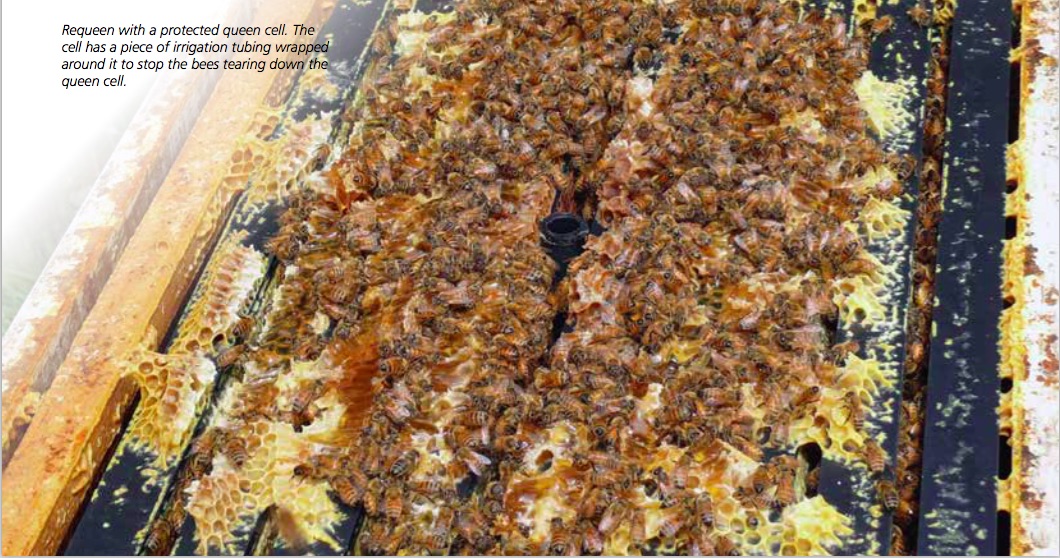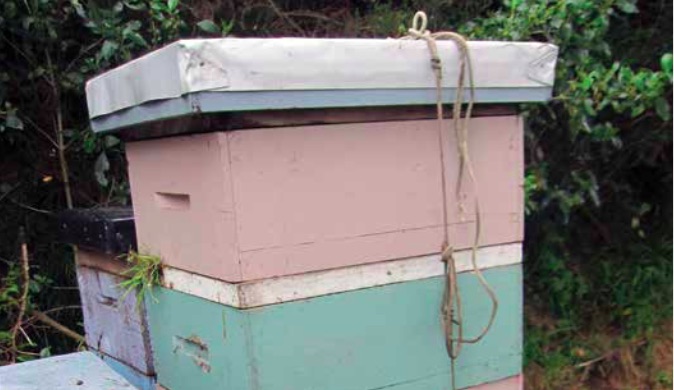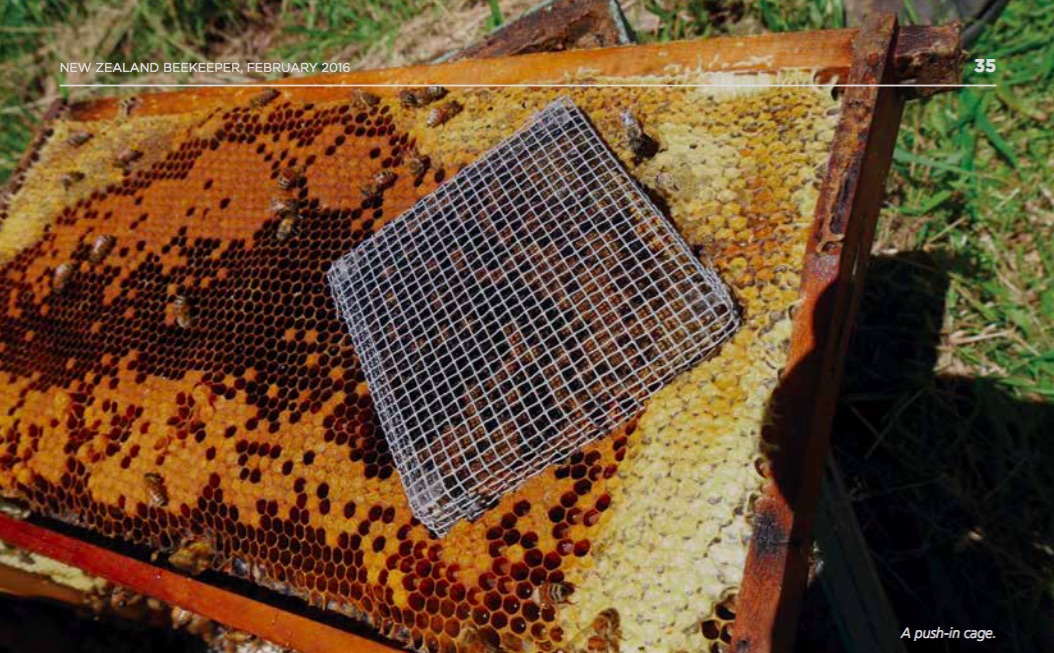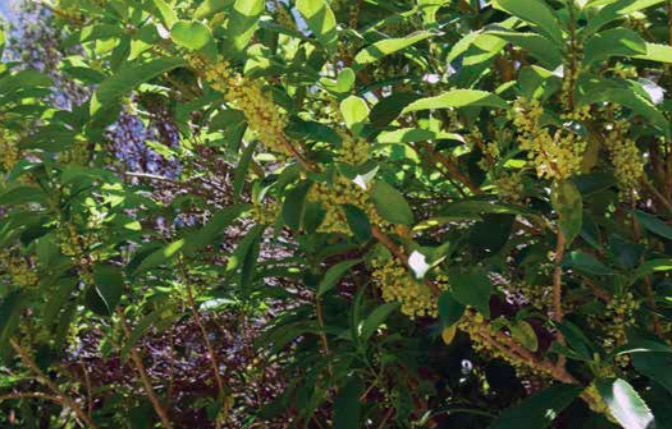
About the Apiary
An informative and sometimes humorous column published in
The New Zealand Beekeeper Journal
REQUEENING AND MAKING NUCLEUS HIVES
About the Apiary - February - 2016As I write this in mid-January, the weather has been perfect for honey production, with rain showers once a week followed by hot, sunny, still days.
As I write this in mid-January, the weather has been perfect for honey production, with rain showers once a week followed by hot, sunny, still days.
Although the honey bees may not have been visiting mānuka, it’s covered with thousands of visiting native bees. Because the bees are offered alternative sources to mānuka, they tend to visit these first. Those areas with just mānuka will have a greater content of mānuka nectar. Koromiko (the last of the flowering sources) now has tiny flower buds, so the end of the season is not too far away.
Time to requeen
Now is the time to undertake one of the major aspects of overwintering by providing all hives with a young queen (i.e., less than two years old with a good laying pattern). You can see this process happening in some of the dud hives, which are now superseding their old queens.
Most commercial beekeepers requeen all their hives during the honey flow by placing a 10-day-old protected queen cell somewhere in the hive that is covered by bees. This method of requeening was developed here in New Zealand by Murray Reid, who used to be an Apicultural Advisory Officer for the Ministry of Agriculture and Forestry (now AsureQuality).
The queen cell is placed in the middle of the third or fourth super (for those who don’t use queen excluders) or in the first super for those who do. This requires a lot of work for those using queen excluders. One of the largest beekeepers in our region places the cells in amongst the bees where they are clustered down on to the floor, as it’s far less work and only takes a minute to do. Queens in cells just before they emerge can tolerate somewhat cooler temperatures at night without too much trouble, although it can delay their emergence slightly.
Queen cells are fragile and should be rejected if dropped or jarred on the eleventh day just before emergence, as this is likely to damage the newly formed wing buds. Success with the queen cells is likely to result in an 80% change of queen so is cost effective for a commercial beekeeper, but generally these cells are not readily available to hobby beekeepers unless they live close to the queen producer. Hobbyists mainly have to rely on obtaining mated queens or making queen cells themselves, which requires a little expertise and practice.
There are a number of ways to produce a small number of queens without adversely affecting the donor colony or needing specialised equipment.

The Miller method
C. C. Miller (USA) developed a method by making the hive queenless and cutting away ‘V’ sections of new comb (removing the bottom from some of the comb) containing eggs. With no bottom to the cells, the bees will develop the larvae into a queen cell, provided other conditions are also met:
• there must be a flow on. Feed the hive sugar syrup with an inverted bottle with half a dozen holes in the lid if the flow has finished
• the hive should be crowded with bees and ample pollen coming into the hive. (In other words, spring conditions in the hive.)
• the section of the hive with the cut-away frame must be queenless.
Find the queen and make a nucleus colony. To do this, take her and the frame she is on, as well as another frame of brood and a couple of frames of honey (covered in bees) and put these in another super above the hive using a split board. For further information, go to Dave Cushman’s website at http://www.dave- cushman.net/bee/millermethod.html
Find the queen and make a nucleus colony. To do this, take her and the frame she is on, as well as another frame of brood and a couple of frames of honey (covered in bees) and put these in another super above the hive using a split board. For further information, go to Dave Cushman’s website at http://www.dave- cushman.net/bee/millermethod.html
The Cloake Board
Another method is the Cloake Board, developed in New Zealand by Harry Cloake. It’s used mainly to raise large numbers of queen cells but it can also be used to raise a few cells. You can find the plans for this at http://www.dave-cushman.net/bee/cloake. html and how to use the board on Dave Cushman’s website at http://www.dave- cushman.net/bee/method2.html
If you want to raise just a couple of cells, you can use the Miller method or a technique called ‘notching’, which basically uses the principles of the Miller method. There’s no need to dequeen the hive if it’s headed by an old queen.
The 'notching' technique is used along the bottom edge of the frame. Taking a very sharp blade, cut away the bottom of a few cells containing eggs (this works better with a newly drawn frame). With no bottom, the bees will make these into queen cells. It may require several attempts before the bees get the idea but as the hive will be crowded and nectar will be coming in, it shouldn’t take the bees long to draw out queen cells.
If there's not much room for the cells to lie straight down, the bees turn the cells to follow along the bottom of the frame. Now you can understand why you missed some queen cells in the spring that caused your best hive to swarm. When covered with bees, these cells are hard to spot.
Equally important is to have mature drones around for the virgin queens to mate with. There should be a lot of drones at this time of the year, but it won’t hurt to put an empty frame in the middle of the brood nest a month earlier so the bees can produce some drones. Use another colony to produce your drones, preferably from one that is a very good honey producer, quiet to handle and wintered well last year.
For those who cannot make queen cells, you are best to purchase a mated queen. Queen introduction is a bit of a science and requires observation of the bees on the cage to see the queen has been accepted before she is released. Too often beekeepers find and remove the old queen, then put in the caged queen with the protective candy exposed for a quick exit. This is a waste of a good queen if there are eggs in the brood cells, as the bees prefer to raise their own and often kill the new queen. Any queen cells the bees have started (cells around the brood area with lots of royal jelly in the bottom) should be scratched out so the bees have no option but to accept the new queen.
Putting a new queen into a full-sized hive is also a waste. The field bees recognise their old queen and will often kill the intruder. You can see this if you put the caged queen on the top bars of a brood super. They will generally ball the cage and grab at the queen, often eating off the queen’s tarsal pads. These pads leave a chemical pheromone wherever the queen walks and is one of the requirements of a good queen. Without these pads, the new queen will be quickly superseded. You can prevent this by putting a piece of tape around half of the mailing cage, so the queen can withdraw to a space where the bees outside can’t get at her feet.
A mated queen in a cage can also be used to identify a queenless hive. The bees will roar when disturbed and will rush to the cage when it’s placed on top of brood frames. Queenless bees are eager to see the queen and react quite differently to a hive with an existing queen. Have a look at the short YouTube video ‘Mike Palmer Queenlessness Test’, at https:// www.youtube.com/watch?v=RX3BgnOkozs

Making up nucs
he best and most successful way to requeen a hive is to make a nucleus colony. If the nuc is placed in the same apiary, the older field bees will fly back to the main hive, which will make it easier to introduce a new queen. Hives are more likely to accept the new queen if there are only young nurse bees in the nuc.
To make a nucleus colony without finding the queen, take two frames of brood with emerging bees or bees about to emerge. Sort through the honey frames and select one of honey and another with honey and pollen. Shake ‘all’ the bees off the frames and place these together in the middle of a new super, with the frames of brood in the centre. Fill in the gaps where the frames were in the super below with drawn frames or foundation. Put on a queen excluder on and then the new super with the bee-less nuc and leave overnight or for three to four hours. The nurse bees will come up through the excluder to look after the brood and the queen is kept below the queen excluder.
Next, take a split board (a crown board with a 25-mm entrance) and put this in place of the queen excluder, thus isolating the top super containing the nuc. Turn the entrance of the split board to the back or side of the hive.
Now take the queen’s mailing cage and place it against the window inside your house, then open the cage slightly and release the escorts. If the queen tries to get out, cover the open part of the cage with your thumb until she moves to the other end of the cage, then uncover the gap and allow more escorts to escape until they are all out.
If the queen gets out, shake out all the escorts and catch her by the wings and put her back into the mailing cage. Don’t try and do this in a car or truck, as the queen will disappear down the air vents, never to be seen again. This happened to me, so now I use a wire queen muff to remove escorts in the field. You can purchase one from the USA firm Kelley Beekeeping. Go to https://www. kelleybees.com/Shop/21/Queens-Bees/ Queen-Rearing/4055/Queen-Muff
Now open the nuc, move the brood frames apart slightly and place the queen cage (candy end up) between the frames of brood and push these together. Three days later, open the nuc and look for queen cell development around the edge of the brood where eggs may have been (i.e., any cells with lots of royal jelly and being build out should be removed). Now the hive is totally reliant on the new queen, and you can release the plastic tab covering the candy plug.
If you are putting these queens into a full-size hive (not making a nuc), observe the bees on the cage after three days. If all the bees are quiet and feeding the queen, you can release the tab. But if just one bee is aggressive (e.g., acting as if it is glued to the cage), don’t remove the tab. Do another inspection for queen cells and leave the queen for another three days, then observe the bees on the cage. Usually you can release the tab at this time and thereafter you shouldn’t open the hive for another two weeks to let the queen and bees settle and allow the queen to start laying.

Push-in cages
Releasing the queen as I've described requires a lot of work, so I prefer to use a push-in cage. I select a frame with emerging brood and shake off all the bees. Press in the push-in cage over some emerging brood and a little nectar in the corner. Lift the edge of the cage and release the queen under the side. If she gets away and flies, leave the hive open with the queen cage on the top bars for half an hour, then look for a ball of bees trying to kill the queen. Remove the bees or drop them in water, retrieve the queen and then put her under the cage. Lift up the cage (it was pushed into the surface of the frame) and release the queen under from the edge of the cage, then press the cage firmly back into the frame surface again.
Leave for nine days, check for any capped queen cells and remove these and remove the cage, thus releasing the queen. She should then take over the colony.
Should I be overwintering nucleus colonies?
I have looked at the long-term weather forecast in Ken Ring’s New Zealand Weather Almanac 2016, and it looks like October this year is going to be wetter than usual for the Wellington district. I have noticed over the years that we get only a two-week period in October that is warm enough (20oC) to mate queens before the equinoctial winds start and the temperature drops again.
Those wanting nucs for spring should consider making them now so these bees can carry hives through the winter. Put aside six frames of honey with pollen, freeze to kill any wax moth larvae and seal in a plastic bag to prevent atmospheric moisture fermenting the honey. This provides the extra food the nuc will need during the winter. Exchange the outside frames when they are nearly empty; i.e., June and September.
Make up nucs consisting of four or five frames and fill them with bees. Feed sugar syrup so eventually there is only brood on the lower parts of the middle frames. Don’t feed during the robbing season when the flow has finished, as your stronger hives will clean them out without entrance protectors in place.
Remove your honey and place the first varroa treatments in the hive
It's very important that bees producing winter bees are free from varroa and viruses. Randy Oliver estimated that we should all be starting our varroa treatments on 18 February. That means every hive within a five-kilometre radius of your hive should be treated at the same time; otherwise you will get mite reinvasion later in the season when untreated hives start to break down and are robbed.
Nearly all treatments require the honey to be removed first but the honey can be left on the hive if you are not ready, provided it has been isolated from the brood supers. Use a clearer board (one fitted with one-way bee escape), or cover the top of the board with newsprint when the majority of bees are below.
It's also very important that these honey supers are totally sealed in. With no bees to guard the cracks, other bees and perhaps the hive below will rob the honey in a few days.
I'm not going to recommend what type of mite treatment beekeepers use, but just make sure you alternate treatments to prevent mites becoming resistant to the treatment (for example, don’t alternate Bayvarol® with Apistan®, as these are basically the same family). Whatever is used, monitor a couple of weeks later after the treatment has finished to make sure it has been effective. Use some sort of wash, as this allows for more accurate mite counts. As you can see from page 45 of the Control of Varroa manual (Goodwin & Taylor, 2007), washing 300 bees with either soapy water (e.g., window washer fluid) or 25% alcohol or methylated spirits is still one of the most accurate methods to determining mite numbers.
Randy Oliver (a Californian beekeeper who has presented at the NBA Conference and at a Waikato field day) also provides information on how to make a shaker bottle: see http:// scientificbeekeeping.com/an-improved-but- not-yet-perfect-varroa-mite-washer/
Tips for removing bees from honey houses
Commercial beekeepers sometimes can’t help bringing in a few bees with their honey supers. These tend to collect on the windows.
Roger Bray figured out the answer to this problem and installed modern sash-type windows in his honey house. These open at the top as well as at the bottom, allowing the bees to fly out.
For those that haven’t figured out an easy way to collect the bees, you could staple a small piece of queen bee pheromone to some cloth and hang this in the window. The bees will readily congregate on the cloth and can be easily removed. This tip came from the Eastern Apicultural Society (EAS) conference 2015 held at Guelph, Canada.
THINGS TO DO THIS MONTH
Check for AFB before removing any honey. Extract honey and if you are in a built-up area, place the wet supers back on the hives after dark for the bees to clean out or refill. Remove comb honey as soon as it’s capped to prevent travel stain: bees have dirty feet.
Rear autumn queens, introduce purchased queens and produce replacement nuclei. Put on entrance closures to make the hive easier to defend. Don’t allow robbing to start when the flow finishes by leaving honey exposed for too long.
Treat for varroa with an alternative to your spring treatment. Treat to knock numbers down if you are going to do a full treatment later.
Keep an eye out for wasps. I haven’t seen many yet but they are out there. Nests are found in ditches and in banks within 500 metres. Kill them with a little insecticide powder down the entrance before they start producing new queens.
It's also a good idea to put out mice baits in a plastic bottle so birds can’t get at them. Rats and mice can do a lot of damage in a hive, so keep their numbers around the apiaries low.

Reference
Goodwin, M., & Taylor, M. (2007). Control of Varroa – A guide for New Zealand beekeepers. Revised edition. Published by the National Beekeepers Association of New Zealand, MAF and HortResearch.
Frank Lindsay